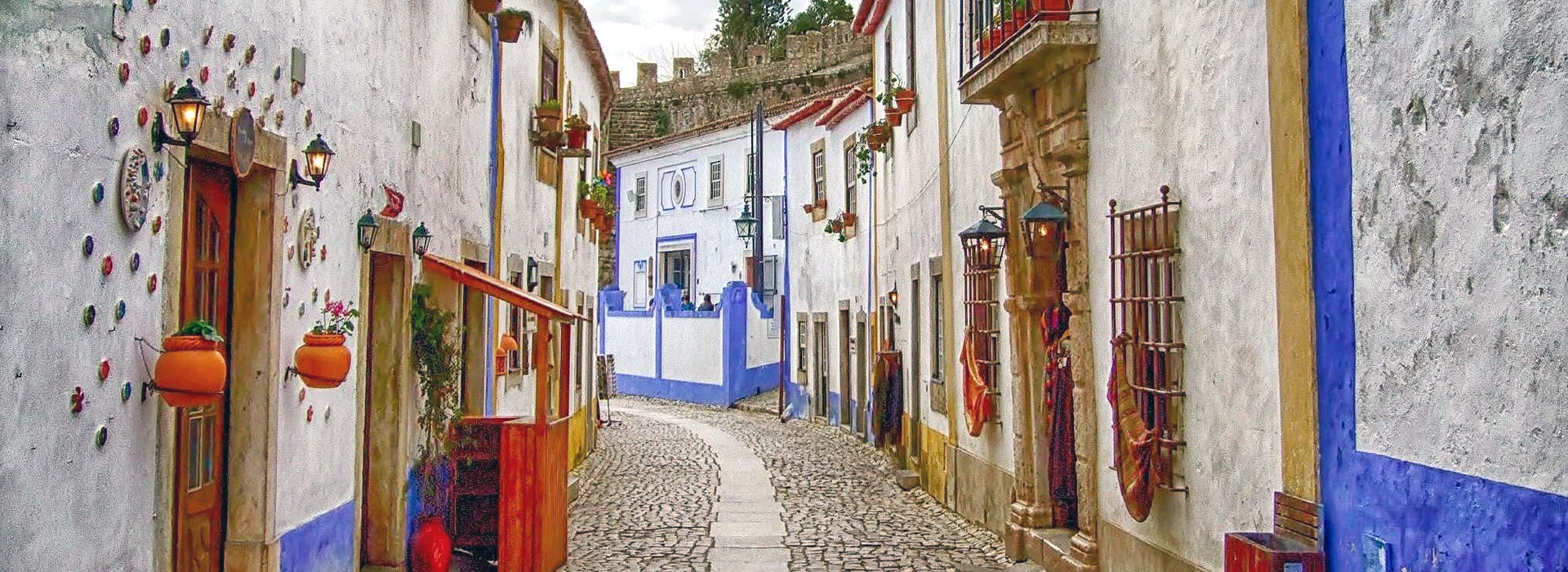
ÓBIDOS
Perched 70m (230ft) high, the medieval town of Óbidos, once gifted to a Queen, stands as one of Portugal's best-preserved walled settlements. Its narrow cobbled streets and whitewashed buildings create a picturesque labyrinth within its ramparts. Just an hour from Lisbon, it's a popular day-trip destination with surrounding areas ripe for exploration. Óbidos also serves as an excellent holiday retreat. MADABOUTSINTRA.COM offers essential guidance for a seamless trip, from sightseeing to dining and accommodation. Don't miss the Vila Natal and Chocolate Festival during Christmas or the International Literature Festival, "O Fólio".
Óbidos' captivating corners, where Renaissance and Baroque houses adorned with flowers, Gothic doorways, medieval churches, and exquisite azulejo tiles enchant visitors and await exploration. A magnet for tourists and artists, Óbidos boasts antique shops, artisanal crafts like woven carpets, and captivating art galleries. Recognised as a National Monument for its unparalleled beauty, the town's popularity and stringent building regulations often make last-minute accommodation challenging, especially in peak seasons. To secure your stay stress free, it's wise to book early and opt for the free cancellation option for added peace of mind.
HISTORY OF ÓBIDOS
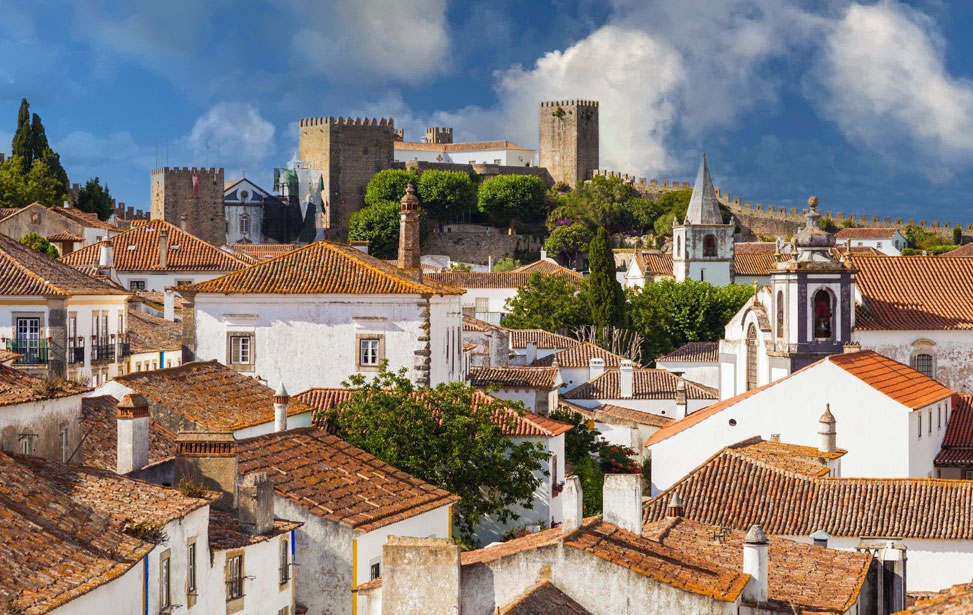
Óbidos Town View
In the Iron Age, Celtic tribes established the first settlements in the area, later becoming a vital trading hub for the Phoenicians. Archaeological excavations near Óbidos have revealed remnants of the Roman city of Eburobrittium, described by Pliny the Elder. Dating from the 1st century BC to the second half of the 5th century AD, these remains include a forum, baths, and other structures. Abandoned by the Visigoths, who resettled to higher ground, Eburobrittium saw further upheaval with the Arab invasion in 713.
Alphonso Henriques' troops captured Óbidos in 1148, marking a significant milestone in the region's history. King Dinis bestowed the town upon his wife Queen Isabel in 1282, initiating a tradition where Óbidos became part of the Queen's patrimony, earning it the moniker "the town of the Queens" until 1834. Royal consorts frequently visited or resided in Óbidos, contributing to its development. The 1755 earthquake inflicted substantial damage, altering the town's Arabesque and Medieval character.

TOP TOURS OF ÓBIDOS
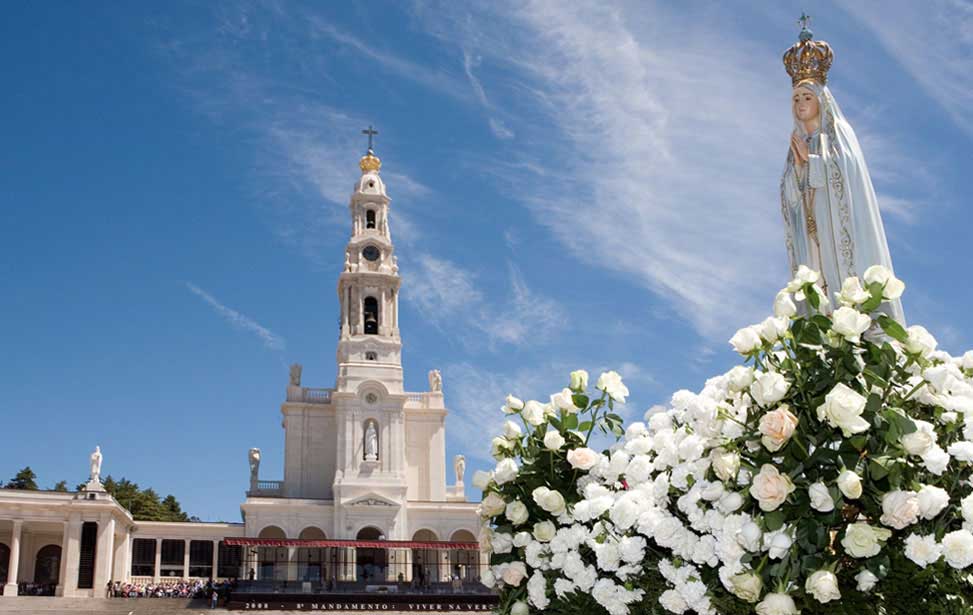
Fátima, Nazaré, and Óbidos Small-Group Day Trip from Lisbon
Experience the rich heritage and stunning Portuguese countryside on this small-group guided day trip to Fátima, Óbidos and Nazaré from Lisbon. On this tour, discover one of the most significant pilgrimage sites, Fátima. You will also visit the small medieval town of Óbidos, glimpse into a fisherman’s life in the seaside village of Nazaré and marvel at the ornate architecture of the UNESCO World Heritage-listed Batalha Monastery. During your journey, savour landscapes boasting beautiful Atlantic coast views, verdant hills and impressive bluffs. Numbers are limited to eight on this small-group tour, ensuring you’ll receive more personalised attention from your guide.
(2,758) | 9 Hr | ✔ Free Cancellation
Check Availability
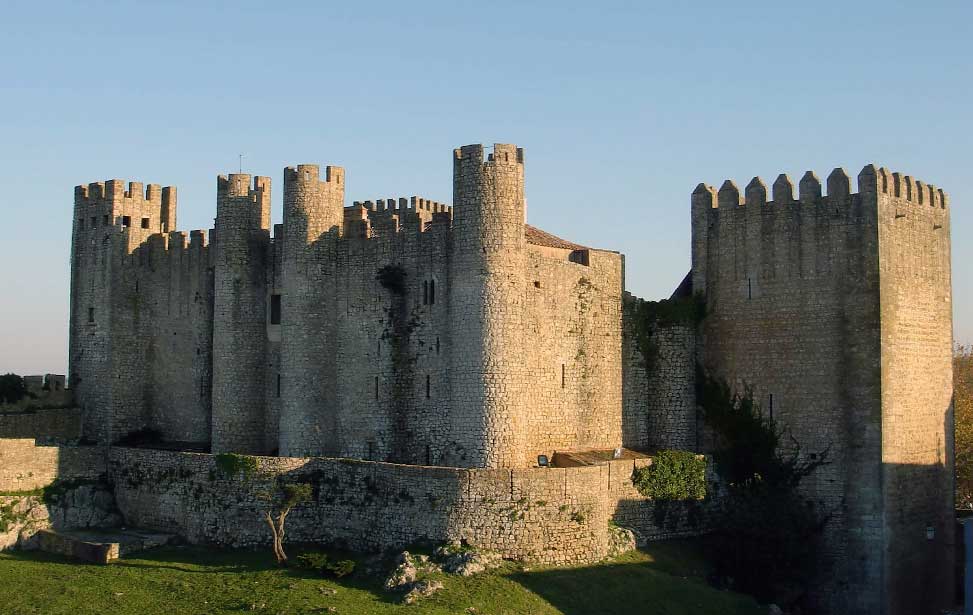
Óbidos historic village and Mafra Palace Private Tour
Step back centuries in time, and see the well-preserved Museum Village on this private tour of Óbidos and Mafra from Lisbon. Wander the streets of a walled town overflowing with a history dating back to the 4th century BC. With your local guide, modify your itinerary to enjoy a more personalised experience.
Depart from Lisbon and discover the fascinating Óbidos’ Museum Village with your guide. Stroll the charming streets of one of Portugal’s most captivating villages. Convenient hotel or port pickup and drop-off included.
(27) | 6 Hr | ✔ Free Cancellation
Check Availability
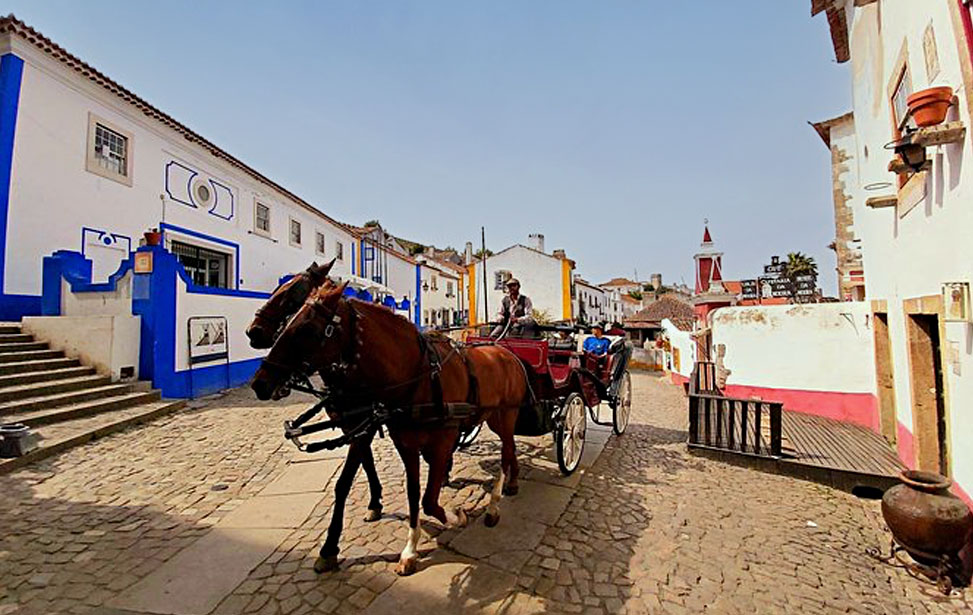
Óbidos Medieval Village World Heritage Private Tour
This tour lets you cover more ground possible than hiring a car. With options to visit three UNESCO-listed attractions—medieval Óbidos and the Alcobaça and Batalha monasteries - and Nazare. Choose a half-day Óbidos trip, or upgrade to a full-day tour of all four, with comfortable transport, guided commentary, and Lisbon hotel pickup and drop-off.
Visit Óbidos, two medieval monasteries, and seaside Nazare in a day from Lisbon. Pick a half-day tour to Obidos or upgrade to a full day to all four sites.
(27) | 7-8 Hr | ✔ Free Cancellation
Check Availability
Disclaimer: tickets are sold and handled via well-established 3rd party tour agents madaboutsintra.com are affiliated. This means we receive a small commission from our partners at no extra cost when you purchase through a link. This helps to cover running costs, and keep our passion alive.
ABOUT ÓBIDOS TOWN
PORTA DA VILA
Porta da Vila became the primary entrance through the town walls after superseding the Southern Gate of Nossa Senhora da Graça in 1380. The gatehouse features a double-gated portal. Restored recently, the ornate ceiling between the doorways showcases a vivid depiction of Christ's crown of thorns. Inscribed with "The Virgin, Our Lady; conceived without original sin" (A Virgem Nossa Senhora foi concebida sem pecado original). It honours the town's patron, the Virgin Mary. Adjacent is Chapel Nossa Senhora da Piedade, adorned with 18th-century azulejo tiles illustrating the Passion of Christ on its balcony. These gates open into Rua Direita, Óbidos' main street. For visitors arriving by coach, Porta da Villa often marks the initial encounter with Óbidos.
Rua Josefa de Óbidos 2, 2510-001 Óbidos, Portugal | 38º 31' 21.3" N | 08º 59' 01.2" W
RUA DIREITA
Once you step through Porta da Vila, you'll encounter the town's primary thoroughfare, Rua Direita. Despite its narrow width, this street has served as the ancient Óbidos' main artery since the 14th century. Over time, the route has evolved, with original Gothic portals discovered in the buildings lining the street. Along Rua Direita, you'll discover a plethora of captivating shops, restaurants, and the pathway to the castle.
Continue down Rua Direita past the town hall, and you'll arrive at the main square, Praça de Santa Maria, home to the town's 15th-century granite Pelourinho (pillory), adorned with the coat of arms of Queen Leonor of Lencastre and a fisherman's net in homage to her son, with the royal heraldic stamp on the reverse side.
AQUEDUCT (AQUEDUTO DA USSEIRA)
The Usseira Aqueduct, also known as the Óbidos Aqueduct, stands as a testament to 16th-century engineering. It was commissioned by Queen Catarina in exchange for the "Várzea da Rainha" (fertile land outside the castle walls). Spanning nearly four miles from Usseira, the aqueduct is a prominent feature south of the walls. Initially flowing underground for two miles, it emerges meandering through vineyards and orchards. Serving a crucial function, the aqueduct supplies water to the town's fountains, including the one gracing the Praça de Santa Maria.
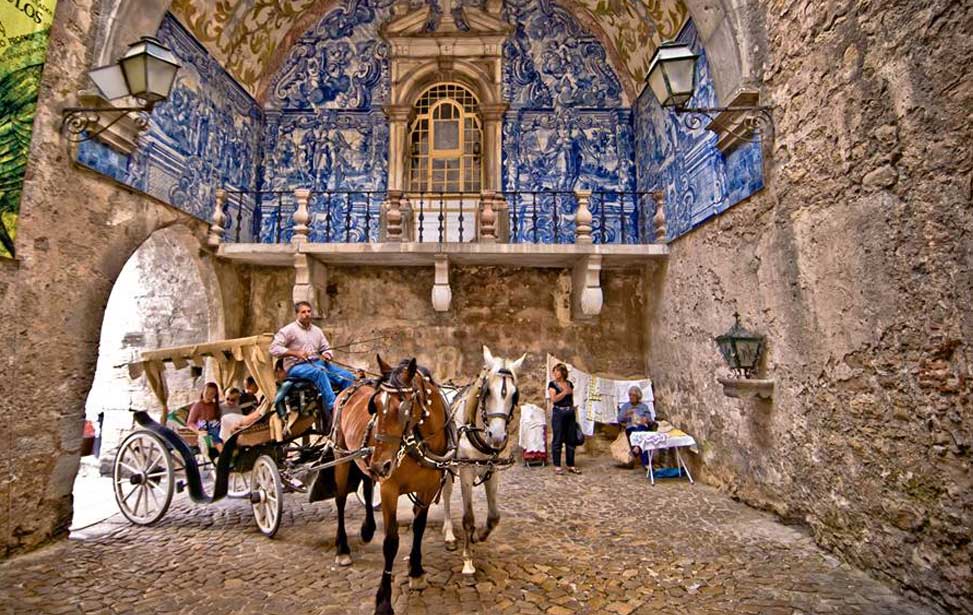
Porta da Vila gatehouse
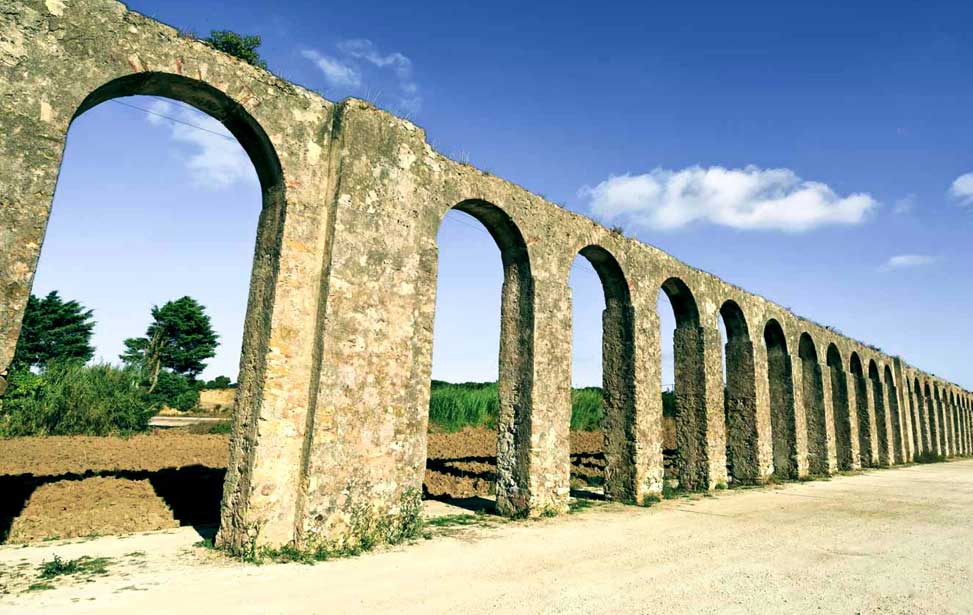
Aqueduct (Aqueduto da Usseira)
IGREJA DE SANTA MARIA
In the heart of Praça de Santa Maria stands the parish church, sharing its name with the square, and tracing its roots to ancient times. Initially established by the Visigoths, the site transitioned into a mosque during Moorish rule before reverting to its Christian identity following Óbidos' reconquest in 1148. Today's structure predominantly reflects 16th-century architecture, largely due to Queen Leonor's efforts to reconstruct the Gothic church.
Venture through its mannerist portal to encounter an interior adorned with azulejo tiles from around 1680-1690. The painted wooden ceiling, dating back to 1676, crowns the three naves, while the retable painted by João da Costa in 1620-1622 graces the altar. Don't miss the tomb of João de Noronha and Isabel de Sousa, a significant piece of Renaissance art, now preserved as a national monument.
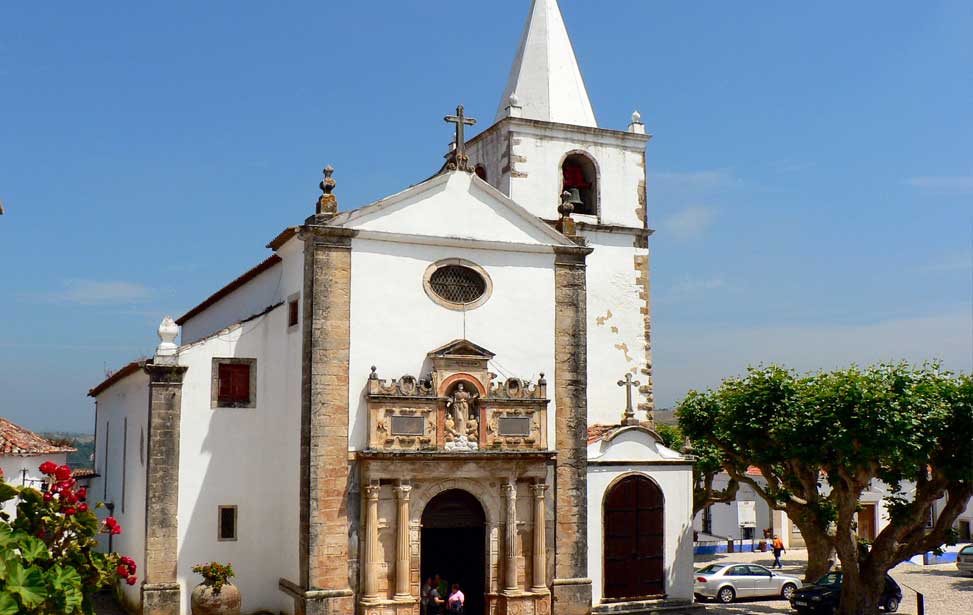
Igreja de Santa Maria church
WHERE TO STAY IN ÓBIDOS
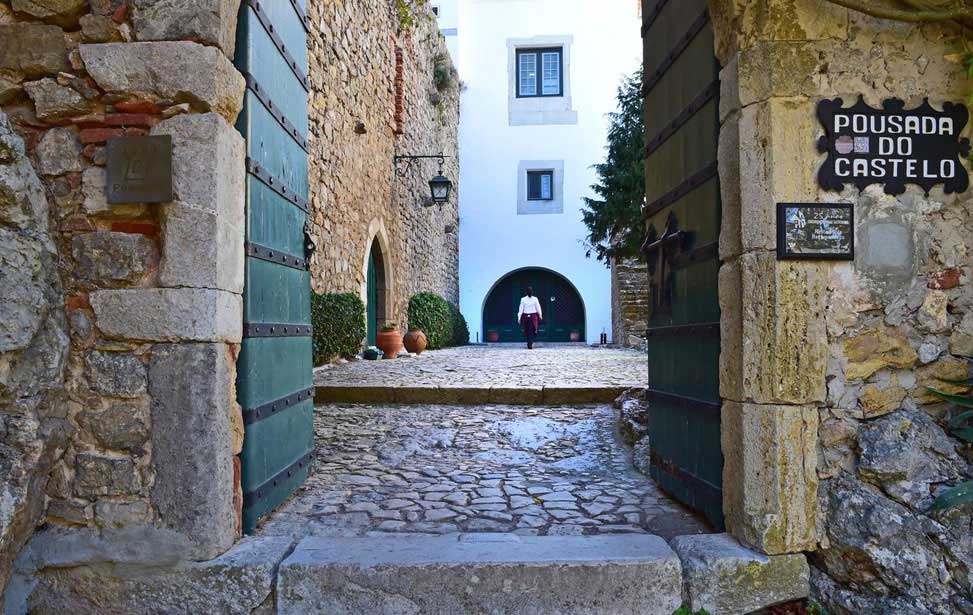
Pousada Castelo de Óbidos ★★★★
8.3/10 Superb (882 verified customer reviews)
Since 1951 the Pousada de Óbidos is installed in the Medieval Castle of Óbido. The adaptation of the Castle into Pousada by architect John Philip Vaz Martins opened up a new concept of utilisation and the recovery of Portuguese Historical Buildings.
Paço Real 2510 - 999, Óbidos, Portugal.
N 39º 21' 47.31" | W 09º 09' 25.34"
Check Avalability
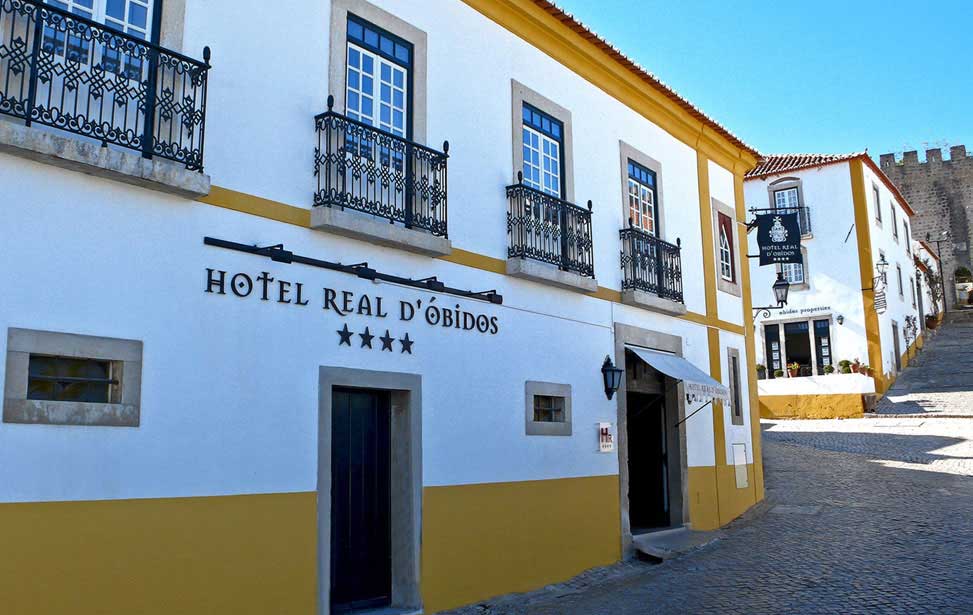
Hotel Real d'Obidos ★★★★
8.8/10 Fabulous (921 verified customer reviews)
Hand in hand with the village's tradition, a hotel was conceived where the rooms are named after the Kings related to the region's history. Each room is decorated and furnished individually, alluding to diverse ages of the region's history. The Hotel has 18 rooms (eight twins and ten doubles), grouped into three categories providing three different classes of lodging: Standard, Superior and Suite (with bedroom and sitting room equipped with sofa bed – two-child allowance). Each room is equipped with air-conditioned, cable TV, telephone, en-suite bathroom, coffee and mini-bar (by request).
Rua D. João de Ornelas 2510-074, Óbidos, Portugal.
N 39º 21' 37.5" | W 09º 09' 29.5"
Check Avalability
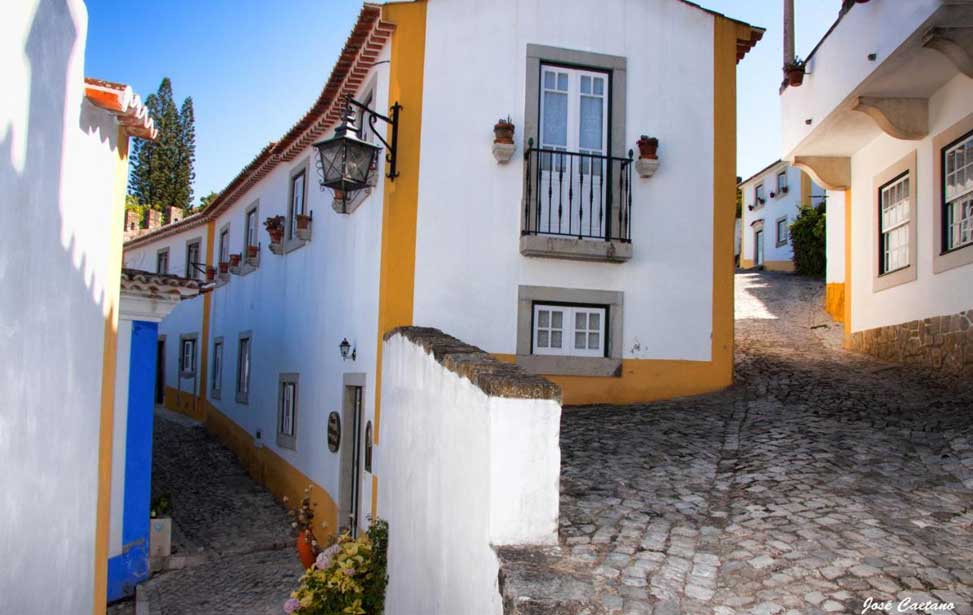
Casa de S. Thiago de Obidos
8.7/10 Fabulous (1,466 verified customer reviews)
Nestled inside the medieval walls of historic Óbidos, this beautiful guest house offers classical-style décor throughout and rooms with town views. It features a living room and a dining room with antique furnishings. The rooms include a cable TV, heating and a private bathroom with amenities. Casa de S. Thiago de Óbidos also has a living room with a TV and is decorated with sofa lounges, wooden furnishings, glass chandeliers and wooden-beamed ceilings. Guests can take a step back in time and enjoy a day of sightseeing through the historical city centre. Óbidos Castle is a five-minute walk away.
12 Rua do Facho, 2510-065 Óbidos, Portugal .
39° 21' 35.4" N | 09° 09' 29.1" W | +351 927 703 322
Check Avalability
GINJA IN CHOCOLATE CUPS
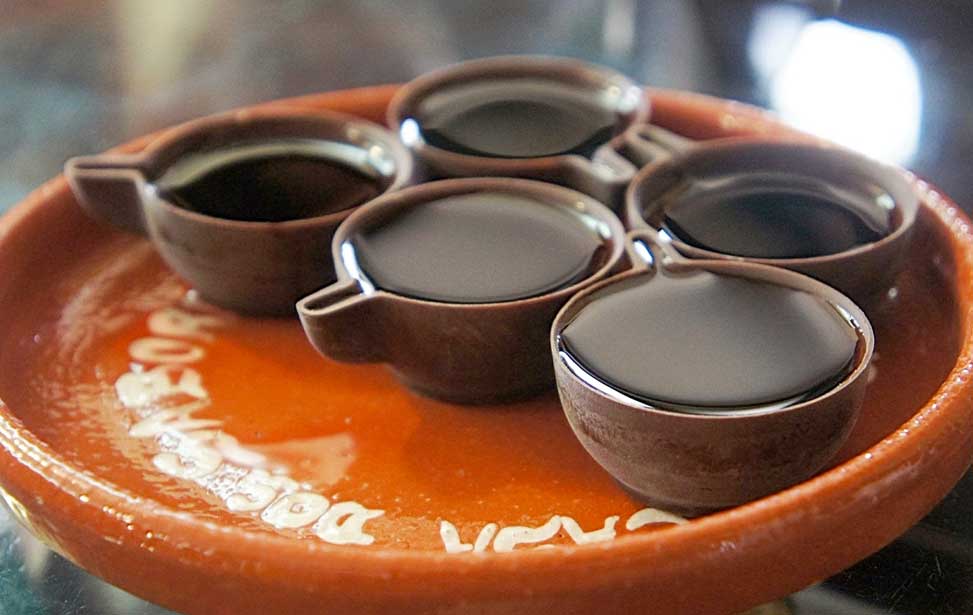
Ginja and Chocolate cups
In Óbidos, the local cherry liquor is an unmistakable signature of the town's culinary heritage. Widely available in shops, cafes, and bars, this cherished liqueur holds a special place in Portuguese tradition, with Óbidos being its esteemed birthplace. Originally introduced by immigrants who worked in the gypsum mines, the tradition of savouring a liqueur after meals quickly embraced the local sour cherry, evolving into the refined delicacy it is today. With its fruity aroma and intricate sweet notes, this liquor has earned EU geographical indication status. A recent trend includes serving Ginja in dark chocolate cups, a delightful combination celebrated in the town's confectioneries and desserts.
For a deeper dive into Ginja production, consider a visit to LicÓbidos - Ginja Mariquinhas, a renowned family-run producer. Explore the fruit's cultivation, maceration techniques, bottling process, and labelling methods, followed by a tasting session and the chance to purchase from their shop. Visits are by appointment only, offering an immersive experience into the world of Ginja production.
Zona Industrial Talhos Novos, Rua Sol Nascente, Fração A e B, Lote 6, Ponte Seca, 2510 - 701 Gaeiras, Óbidos, Portugal. N 39º 22' 13.1" | W 09º 06' 15.3"
+351 262 601 544 |
geral@licobidos.com | Website
ÓBIDOS CASTLE
Óbidos Castle stands as a timeless sentinel atop the highest point of Óbidos, Portugal. Dating back to the Moorish occupation in the 8th century, this historic fortress has witnessed centuries of conquests and reconstructions, embodying the rich tapestry of Portuguese history. Its sturdy stone walls and imposing towers offer panoramic views of the surrounding countryside, inviting visitors to step back in time and explore its labyrinthine passages and hidden chambers.
Once the wedding gift of King Dinis to his bride Queen Isabel in the 13th century, the castle showcases a blend of architectural styles, from Moorish to Gothic. Today, it serves as a cultural landmark, hosting events such as the renowned Óbidos Medieval Festival. Guided tours offer insight into the castle's storied past, while visitors can also stroll through its picturesque courtyards and enjoy exhibitions within its walls. A visit to Óbidos Castle promises a journey through Portugal's captivating history, set against a backdrop of timeless beauty. Today it serves as the town's Pousada (state hotel). It's referred to as one of the seven wonders of Portugal and, at the time of writing, awaiting a UNESCO classification of World Heritage.

SANTUARIO DO SENHOR JESUS DA PEDRA
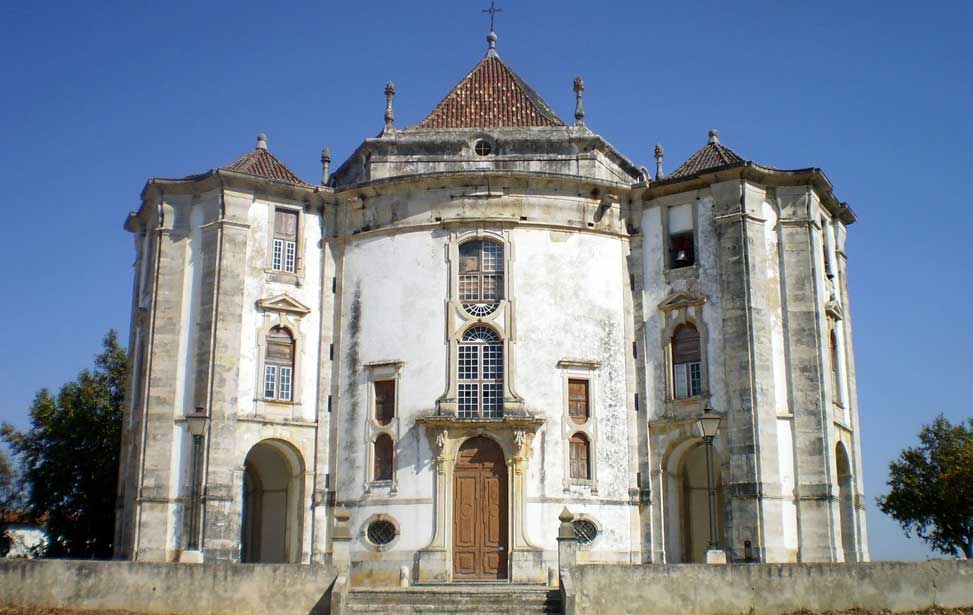
Santuario do Senhor Jesus da Pedra
Located just a short distance northeast of Óbidos, the Santuario do Senhor Jesus da Pedra is an architectural gem dating back to the 18th century. This baroque-style church boasts a distinctive hexagonal floor plan, a rarity in religious architecture. Designed by Captain Rodrigo Franco of the Mitra Patriarchal, the church holds special significance for King João, who commissioned its construction as a tribute to surviving a near-fatal accident, invoking Our Lord Jesus of the Stone.
Construction of the Santuario do Senhor Jesus da Pedra took place between 1740 and 1747, with meticulous attention to detail evident throughout its design. Inside, visitors can admire a Paleo-Christian cross dating back to the second or third century, sourced from a nearby chapel. The church features three chapels, each dedicated to different aspects of religious devotion, including the Calvary, Our Lady of Conception, and the Death of St. Joseph, adorned with exquisite paintings by acclaimed artist José da Costa Negreiros. A visit to this historic church offers a glimpse into Óbidos's rich religious heritage and architectural splendour.
Contact Details:
Largo do Santuário, 2510 Óbidos, Portugal.
39° 21' 23.00" N | 09° 09' 24.00" W
WHERE TO EAT IN ÓBIDOS
Restaurante O Caldeirão
A short stroll from the historic centre is a welcoming spot that delights both locals and tourists with its authentic Portuguese cuisine. Known for its friendly service, this restaurant offers a diverse menu showcasing local flavours, with options to satisfy every palate. The seafood rice and grilled meats are particularly popular, highlighting fresh, regional ingredients prepared carefully.
The restaurant also boasts an excellent wine list, featuring quality Portuguese wines that perfectly complement the menu. Whether you're after a traditional dish or something lighter, the staff is happy to help you select the best wine pairing. The warm, rustic atmosphere creates a relaxed dining experience, making it a great choice after a day of exploring Óbidos. With reasonable prices and generous portions, Restaurante O Caldeirão is a must-visit for those seeking a genuine taste of Portugal’s culinary heritage.
Largo do Santuario, Caxinas, Senhor da Pedra, Obidos 2510-072, Portugal.
39º 21' 53.6" N | 09º 08' 59.5" W | +351 262 959 839
restauranteocaldeirao@gmail.com |
Facebook
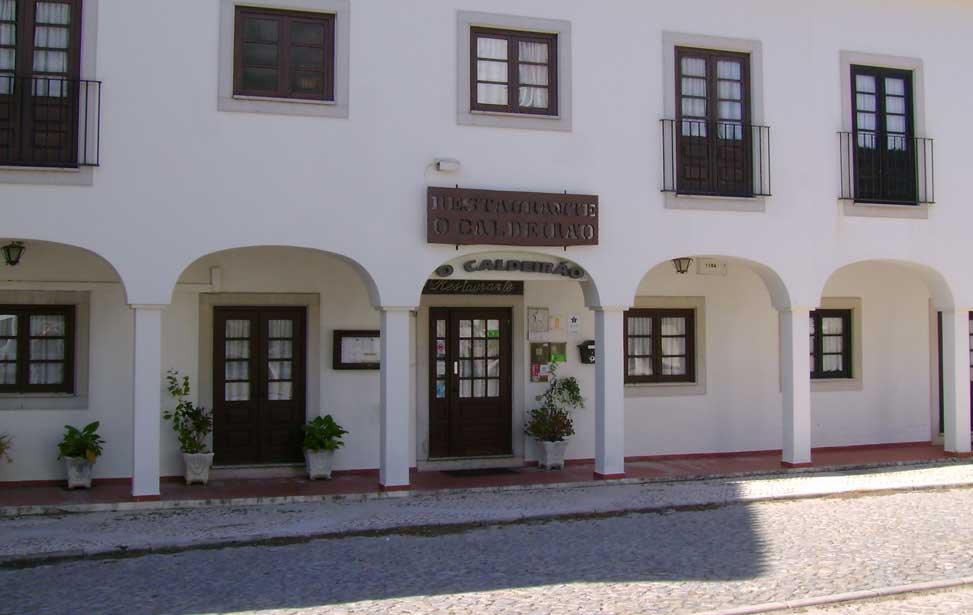
Restaurante A Ilustre Casa De Ramiro
Restaurante A Ilustre Casa De Ramiro is a charming spot that brings history to life through its medieval-inspired décor and welcoming atmosphere. Located close to the town walls, this cosy restaurant, with a capacity of 50, offers a unique dining experience steeped in Portuguese tradition. Inspired by the novel A Ilustre Casa de Ramires by famed author Eça de Queiroz, the restaurant transports diners back in time with its ambience, complete with fine music and friendly service.
The menu focuses on traditional Portuguese cuisine, with select dishes grilled right before you, adding to the authenticity of the experience. Local favorites include grilled meats and fresh seafood, cooked to perfection with a hearty, rustic flair. Perfect for history buffs and food lovers, A Ilustre Casa De Ramiro offers a memorable culinary journey blending fine flavours with a welcoming medieval charm.
Daily: 10h00 - 23h00, Thursday: CLOSED
Rua Porta do Vale, 2510-084 Óbidos, Portugal.
39º 21' 40.49" N | 09º 09' 21.02" W | +351 262 959 194
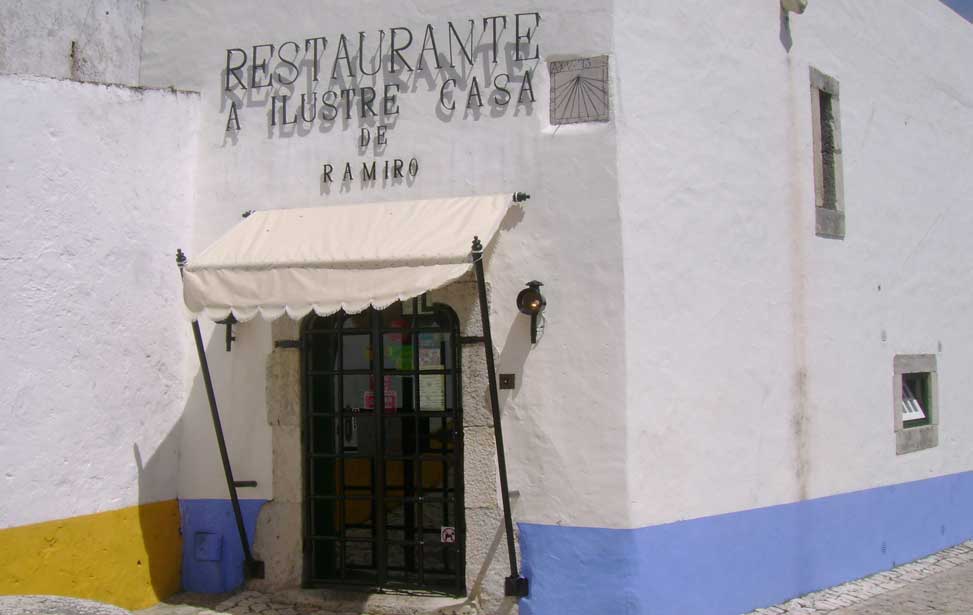
Restaurante Alcaide
Ensconced within the town’s ancient walls, Restaurante Alcaide offers traditional Portuguese cuisine that combines authenticity and quality. Small yet inviting, this unpretentious spot charms guests with a friendly, family-like atmosphere and attentive service. The menu highlights freshly prepared dishes that showcase local ingredients and flavours; the grilled seafood and tender meats are especially popular.
Despite the high culinary standards, prices remain reasonable, making it accessible for both locals and visitors eager to experience Portuguese cooking. The extensive wine list is carefully curated, featuring excellent regional options that pair beautifully with each dish. With a relaxing setting and a warm ambience, Restaurante Alcaide invites you to enjoy a relaxed meal that’s as authentic as it is memorable. For anyone exploring Óbidos and looking to savour true Portuguese flavours within the historic walls, Restaurante Alcaide is a must-visit.
Rua Direita 60, 2510-001 Óbidos, Portugal.
39º 21' 48" N | 09º 09' 26.8" W | +351 262 959 220 | Website
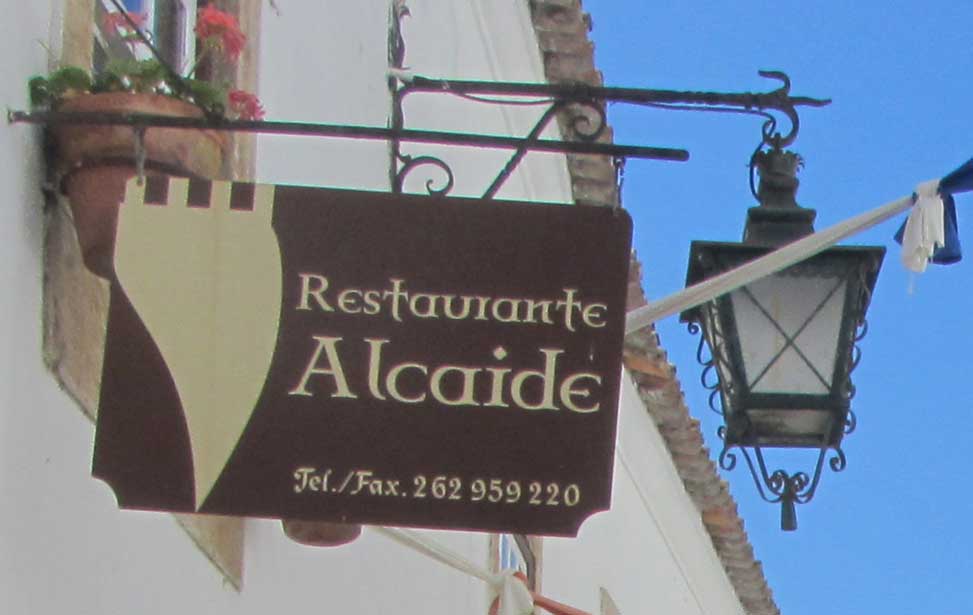
LAGOON (LAGOA DE ÓBIDOS)
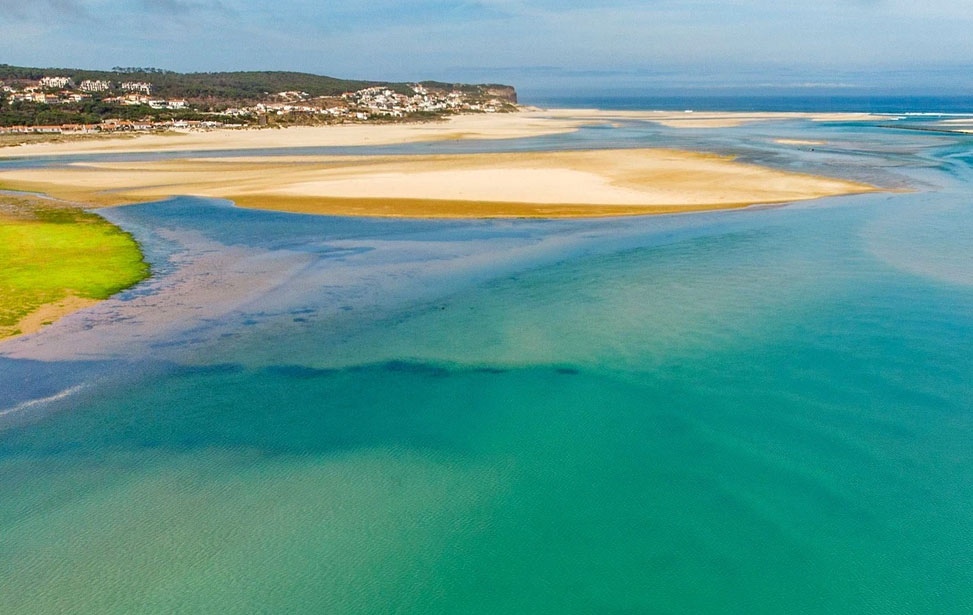
Lagoa de Óbidos
Portugal's largest lagoon system, spanning roughly three square miles, boasts an average depth of only two metres. Historically, the lagoon's waters reached the walls of Óbidos, but centuries of silting have pushed it five kilometres (3 mi) westward. Today, the lagoon's integrity is preserved through regular dredging, supporting various water activities and sustaining the local fishing economy.
The picturesque beach at Foz do Arelho, located where the lagoon meets the sea, is a highlight of the area. Its golden sands and tranquil waters make it perfect for sunbathing, surfing, paddling, and family outings. Along the seafront, a handful of cosy cafés and restaurants cater to visitors' needs, providing refreshments and local cuisine against the backdrop of the stunning coastal scenery. Whether seeking relaxation or adventure, Foz do Arelho offers an idyllic seaside escape for all.

ÓBIDOS DOC WINES
Formally known as Estremadura, the Lisboa wine region runs the height of western Portugal from Lisbon in the south to Leiria in the north. The Vinho Regional Lisboa incorporates nine demarcated regional wine styles, including the Óbidos DOC. The red wine is soft, open and slightly scented, whereas the white is fresh with fruity aromatic flavours. Cool and damp terroir is ideal for producing sparkling wines found here in abundance. Labels such as:
Quinta do Gradli
(visits Monday - Saturday: 11h30 - 15h30)
Website
Quinta do Sanguinhal
(visits weekdays: 10h30 - 15h00)
Website
and Quinta das Cerejeiras are well worth seeking out.
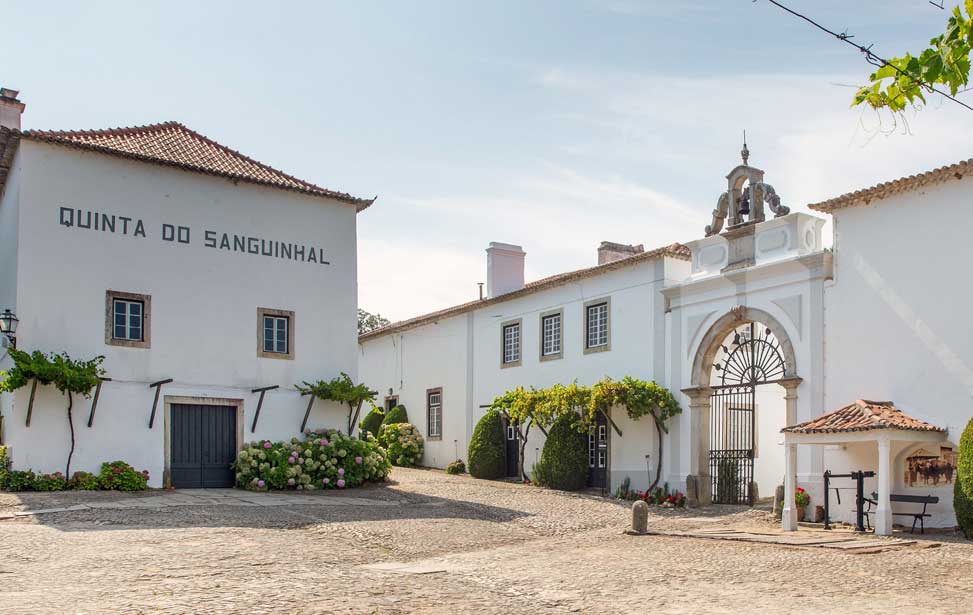
Quinta do Sanguinhal winery
HOW TO ARRIVE IN ÓBIDOS
80km (50 miles) North of Lisbon Portela Airport Website GET A GREAT DEAL ON FLIGHTS:
|
|
80km (50 miles ) north of Lisbon along the A8 direct to Óbidos. From Santarém take the A15 east, and from Porto take the A1 south to Leiria, then the A8 directly to Óbidos. GET A GREAT DEAL ON CAR HIRE:
| |
Regional train services (comboios regionais) to Óbidos train station from Lisbon, Coimbra, Leira and Figueira da Foz:
• Linha do Oeste
Timetable |
|
|
• Rodoviária do Tejo: Óbidos to/from Lisbon Website |

 Lisbon Card Discounts
Lisbon Card Discounts

 Travel & Tourism Awards 2024, Best Lisbon Travel & Cultural Guide 2024 - UK
Travel & Tourism Awards 2024, Best Lisbon Travel & Cultural Guide 2024 - UK

